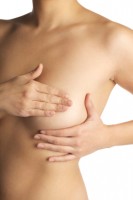Much has been written about mastectomy (breast ablation) after Angelina Jolie had both her breasts removed (more precisely, the content of both breasts) to reduce risk of getting breast cancer later. I do not want to discuss the pros and cons of such “prevention measure” here. Mastectomy is still common in the treatment of breast cancer, whereby doctors try to remove as few of the healthy tissue as possible.
In any case mastectomy is very burdening for women concerned and most of them wish for a breast reconstruction after such a surgery, which can be performed in different ways. Women who attach importance to naturalness and do not want any foreign substances such as silicon inside their body decide for autologous fat transfer. In every autologous fat transfer autologous stem cells contained in the fat tissue are transplanted as well. When enriching the fat to be transplanted with stem cells, we call it “stem cell-enriched fat transfer into the breast” or casually “stem cell breast augmentation”.
The usage of stem cell-enriched autologous fat for breast reconstruction following cancer surgeries was performed successfully in many hundreds of patients in Japan since 2003. A long-term study regarding this neither revealed any complications nor new development of cancer.
Breast augmentation with stem cells extracted from the body’s own fat can be used both for aesthetic corrections such as breast augmentations and reconstructive breast surgeries. During the procedure a small amount of the patient’s fat is harvested by manual liposuction, which is then enriched with the body’s own stem cells. Immediately afterwards this stem cell-enriched fat is injected into the breast tissue concerned to accomplish new volume there.
A breast reconstruction with stem cells extracted from autologous fat following cancer surgery should be performed only after the end of cancer therapy.
Depending on the breast’s condition a pretreatment for stretching the breast tissue could be necessary. This can be done by wearing a special mechanic suction bra (there are different systems) in order to make room for the later injected autologous fat.
The result of a breast reconstruction with stem cells is a well-shaped breast that does not only look natural in every position but also feels “real”. Because of the additional local rejuvenating effect of the stem cells the tissue gets firmer. The additional volume is mostly sustainable. Thus repeat treatments are rarely necessary. Results may vary from patient to patient. Please note that in medicine generally no guarantee for a certain treatment result can be given.
The whole procedure is done in two to four hours and is performed exclusively under local anesthesia, without the need of general anesthesia or inpatient stay.
DDr. Heinrich, MD
